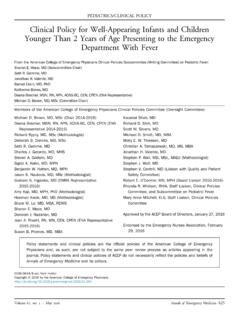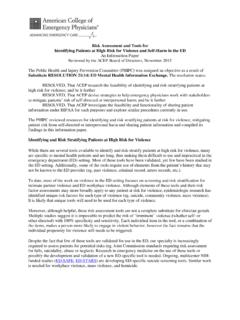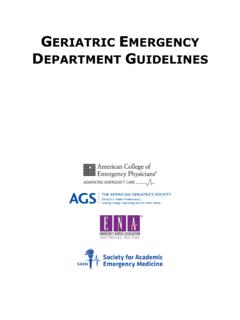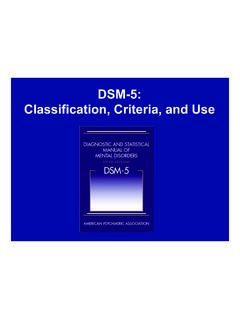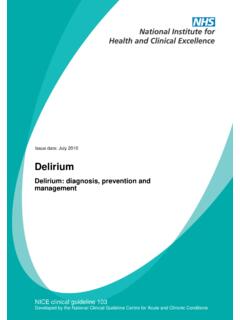Transcription of Example Policies / Protocols Guidelines & Procedures
1 Example Policies / Protocols Guidelines & Procedures TABLE OF CONTENTS Access to Geriatric Emergency Department Care from ED Confusion Assessment Method: Geriatric Delirium Screening in the ED ..10 Standardized Dementia Screening Protocol ..12 Standardized Assessment of Function and Functional Decline ..13 Fall Risk ..14 Identification of Elder Abuse ..16 Medication Reconciliation with Pharmacist ..17 Potential Inappropriate Medication ..19 Pain Control ..22 Accessing Palliative Care Consultation ..26 Geriatric Psychiatry in the Emergency Department.
2 2 9 Development & Implementation of Presentation Order Sets ..31 Prevention of Catheter associated Urinary Tract NPO Designation ..35 Volunteer Engagement ..38 Discharge Planning Services Home Health Skilled Services Referrals ..39 PCP Notification ..40 Transition of Care to Residential Care ..41 Minimize use of Physical Restraints ..42 Standard Access/Referral to Geriatrics Specialty Clinic and REACH home visit ..44 Discharge/ Outreach Access to Transportation Service for Return to Residence ..51 Short or Long-term Rehabilitation Services.
3 52 Outreach Program Home Assessment ..53 Active Relationship with Community Paramedicine ..59 Example Policies / Protocols Guidelines & Procedures Access to Geriatric Emergency Department Care from ED Triage Our Academic Emergency Department has several unique areas, including a 20-bed observation unit, a 15-bed oncology unit, critical care bays, trauma bays, and a quick care or fast track area. All nurses and staff receive training to become better providers of care for our geriatric patients. Areas where we have focused our geriatric mission are the ED Observation Unit and our ED oncology unit.
4 We also have developed a care continuum for our ED patients with specialized geriatric care on several admission teams (NICHE unit, Geriatric Trauma, and Geriatric Orthopedics). ED Staffing: a. ED nurses: All ED nurses undergo 2 hours of geriatric training with 1 hour of information about older adult physiology and 1 hour on specific hospital; Protocols and screening tools. b. Geriatric Consultation team: led by a board-certified geriatrician and includes geriatric NP, geriatric fellows, residents, and medical students. Available Monday Saturday, business hours.
5 C. Physical therapy: We have of a dedicated physical therapist in the ED as well as additional assistance from float PTs when there are further consults requested. d. Occupational therapy: We have a dedicated occupational therapist assigned to the ED. These therapists work with many of our frail older adults and stroke patients. As this is an innovation, the therapists are currently assigned in 4 month blocks so that they become very comfortable with the ED patients and flow. e. Case management: Our team consists of 6 full time nurse case managers for the ED and Observation Unit as well as a team with oncology care need specialization in the ED section.
6 F. Social work: Our team consists of 7 full time social workers for the ED and Observation Unit as well as a team with oncology care need specialization in the ED section. g. Pharmacists: A team of 7 full time specialty practice pharmacists provides 19 hours/day of coverage in the ED. ED care: a. Triage Nurses: Triage nurses are experienced ED nurses. They will perform an initial assessment including vitals, document chief complaint, and the patient's Richmond Agitation Sedation Scale (RASS). A nonzero RASS has very good sensitivity and specificity for delirium (Han, AEM 2015).
7 An older adult with a non-zero RASS should also have an ESI of 1 or 2. From our Jan 2018 data (most recent month available), a RASS was documented for of ED patients. The nurse will then assign an ESI level and often will order initial diagnostic testing if there is an expected wait of over 30 minutes to get the patient to a bed. b. Patient flow coordinators: These experienced ED nurses consider the patient flow through the entire ED and help assign patients to the correct area (Cancer ED, Arrival zone (fast track or minor complaints area), critical care bay, trauma bay, general bed, or Observation Unit).
8 A patient with a non-zero RASS is at high risk of poor outcomes and prolonged length of stay and so will be placed in a non- Obs bed unless no other bed is available. Otherwise, stable older adults without delirium and without active cancer (Cancer ED) will be prioritized for placement in the Observation Unit. c. Geriatric Assessments: Multidisciplinary geriatric assessment is available to any ED patient and includes physical therapy, occupational therapy, speech therapy (also do cognitive assessments), case manager evaluations of home needs and resources, social work evaluations (mandatory if concern for abuse/neglect), medication review by pharmacy team, and geriatric consultation.
9 Because these assessments are available during business hours only (other than social work which is available 24/7), patients in need of geriatric assessment are placed in the Observation Unit for continued medical care until the following morning. Our older adults have an average length of stay in Observation of ( ) hours with a goal of <24 hours. A full Observation Unit does not preclude more patients being assigned to observation status and these teams can evaluate patients in any bed in the ED. Figure 1: Flowsheet for care of older ED patients.
10 Upon admission, patient to be assessed for appropriateness for the NICHE unit. ED Observation Unit: a. Description: The EDOU is a 20-bed unit dedicated to patients who require ED care and interventions that will require more than 4 hours. The unit is staffed by a group of 25 dedicated nurses with training in ED and Observation care. The staffing ratio is 5:1 in addition to a charge RN and two patient care associates. This unit is staffed 24 hours a day. There is a dedicated advanced practice provider 24/7 and ED attending dedicated coverage for 4-5 hours each morning for rounds.



